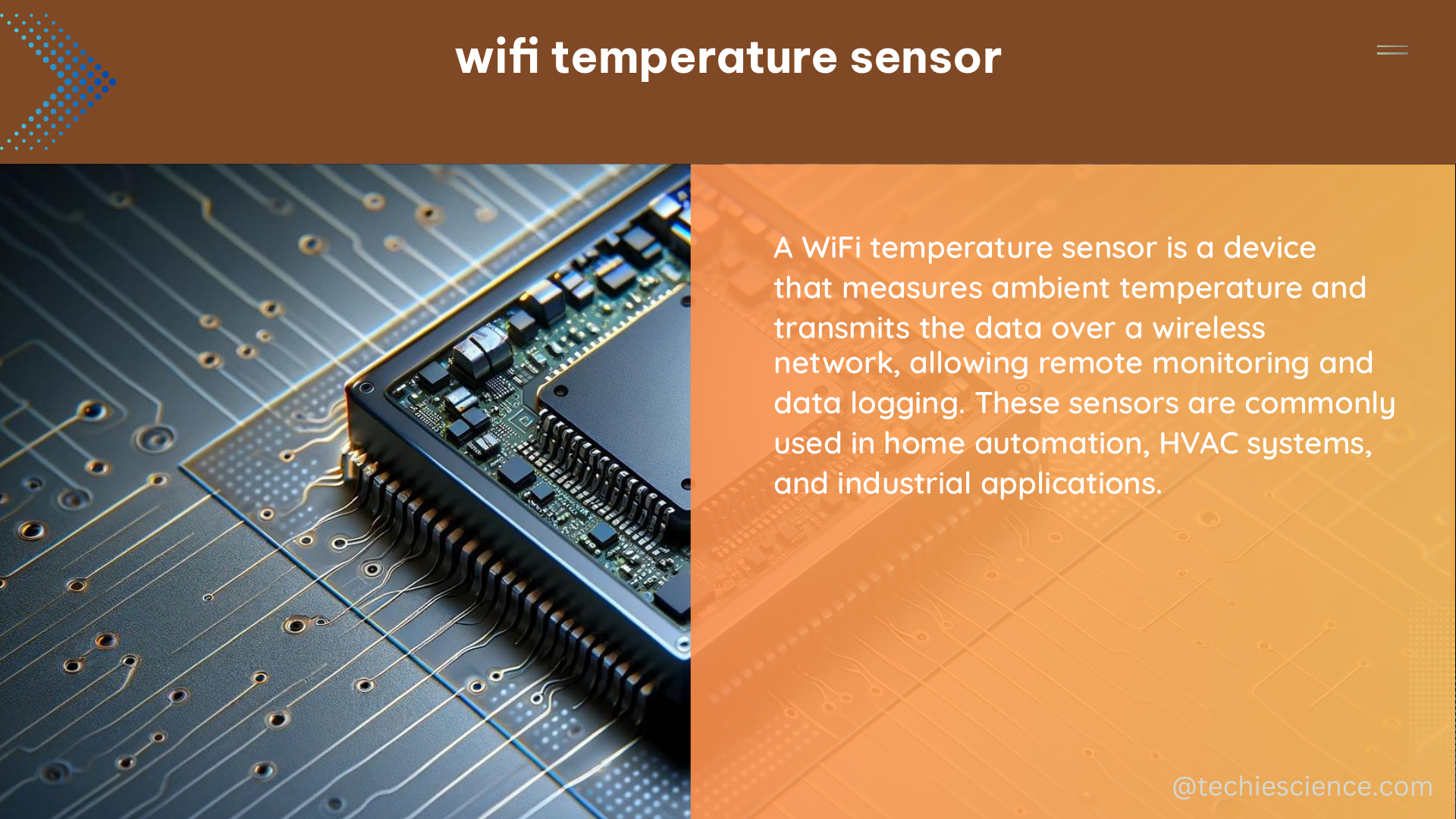The Wi-Fi temperature sensor is a cutting-edge technology that has revolutionized the way we monitor and control temperature in various applications. This comprehensive guide will delve into the intricate details of this remarkable device, equipping you with the knowledge and skills to harness its full potential.
Understanding the Fundamentals of Wi-Fi Temperature Sensors
Wi-Fi temperature sensors are designed to measure and transmit temperature data wirelessly using the Wi-Fi protocol. These sensors are equipped with a temperature-sensing element, such as a thermistor or a resistance temperature detector (RTD), which converts the temperature into an electrical signal. This signal is then processed by the sensor’s microcontroller and transmitted over a Wi-Fi network to a central monitoring system.
One of the key advantages of Wi-Fi temperature sensors is their ability to operate without the need for a wired connection, making them highly versatile and easy to deploy in a wide range of environments. These sensors can be powered by a variety of sources, including batteries, solar panels, or even the Wi-Fi network itself, depending on the specific design and application requirements.
Sensor Specifications and Performance Characteristics

When selecting a Wi-Fi temperature sensor, it’s crucial to consider the following technical specifications and performance characteristics:
Temperature Range and Accuracy
- Temperature range: Typical ranges include -40°C to 125°C (-40°F to 257°F) or -20°C to 85°C (-4°F to 185°F), depending on the sensor model.
- Temperature accuracy: Commonly ranging from ±0.5°C to ±2°C (±0.9°F to ±3.6°F), with higher-end sensors achieving ±0.1°C (±0.18°F) or better.
Sampling Rate and Response Time
- Sampling rate: Varies from 1 sample per second to 1 sample per minute, depending on the application requirements.
- Response time: Typically ranges from 1 second to 30 seconds, depending on the sensor design and thermal mass.
Power Consumption and Battery Life
- Power consumption: Varies from a few milliwatts to several watts, depending on the sensor’s features and communication protocol.
- Battery life: Can range from a few months to several years, depending on the power consumption, battery capacity, and duty cycle.
Wireless Communication and Range
- Wireless protocol: Commonly uses Wi-Fi (802.11b/g/n/ac) with a range of up to 100 meters (330 feet) in an open-field environment.
- Data transmission: Typically supports various data formats, such as JSON, XML, or proprietary protocols, for integration with monitoring systems.
Environmental Resistance
- Ingress protection (IP) rating: Ranges from IP54 (dust and splash-proof) to IP67 (dust-tight and waterproof) or higher, depending on the sensor’s intended use.
- Temperature and humidity resistance: Designed to withstand a wide range of environmental conditions, often following the NEMA TS2 standard for traffic control assemblies.
Sensor Deployment and Integration
Deploying Wi-Fi temperature sensors involves several key considerations:
Sensor Placement and Mounting
- Optimal sensor placement: Depends on the specific application, such as monitoring ambient temperature, surface temperature, or air flow.
- Mounting options: Include wall-mounting, ceiling-mounting, or portable/mobile configurations, with various bracket and enclosure options.
Network Configuration and Connectivity
- Wi-Fi network requirements: Sensors typically support 2.4 GHz and 5 GHz Wi-Fi networks, with support for WPA2 or WPA3 security protocols.
- Network integration: Sensors can connect directly to a Wi-Fi router or access point, or integrate with a dedicated IoT (Internet of Things) gateway or cloud platform.
Data Monitoring and Visualization
- Data collection and storage: Sensor data can be stored locally on the device or transmitted to a central monitoring system, cloud platform, or building management system.
- Data visualization: Sensor data can be displayed on a web-based dashboard, mobile app, or integrated into existing building automation or facility management software.
Advanced Features and Applications
Wi-Fi temperature sensors are not limited to basic temperature monitoring; they can also offer advanced features and applications:
Sensor Networking and Mesh Topologies
- Sensor networking: Sensors can be configured to form a mesh network, allowing for extended coverage and redundancy in large-scale deployments.
- Mesh networking protocols: Examples include Wi-Fi Mesh, Zigbee, or proprietary mesh protocols, depending on the sensor’s capabilities.
Sensor Analytics and Predictive Maintenance
- Data analytics: Sensor data can be analyzed to detect anomalies, identify trends, and predict potential equipment failures or maintenance needs.
- Predictive maintenance: By monitoring temperature patterns and correlating them with equipment performance, Wi-Fi temperature sensors can help optimize maintenance schedules and reduce downtime.
Integration with Building Automation and IoT Platforms
- Building automation systems: Wi-Fi temperature sensors can be integrated with HVAC, lighting, and other building systems to optimize energy efficiency and comfort.
- IoT platforms: Sensor data can be seamlessly integrated with cloud-based IoT platforms for remote monitoring, data visualization, and advanced analytics.
Conclusion
Wi-Fi temperature sensors have become an indispensable tool in a wide range of applications, from industrial facilities and commercial buildings to smart homes and agricultural operations. By understanding the technical specifications, deployment considerations, and advanced features of these sensors, you can unlock their full potential and leverage them to enhance your temperature monitoring and control strategies.
References:
- Wireless Sensor Network for Traffic Monitoring Based on the LoRa Technology
- A Comprehensive Review of Wireless Sensor Networks for Air Quality Monitoring: Challenges, Solutions, and Future Research Directions
- Wireless Sensor Networks for Environmental Monitoring: A Survey on the Impact of Radio Irregularity
- Deployment and Evaluation of a Wireless Sensor Network for Traffic Monitoring
- SmartMesh IP Application Notes

The lambdageeks.com Core SME Team is a group of experienced subject matter experts from diverse scientific and technical fields including Physics, Chemistry, Technology,Electronics & Electrical Engineering, Automotive, Mechanical Engineering. Our team collaborates to create high-quality, well-researched articles on a wide range of science and technology topics for the lambdageeks.com website.
All Our Senior SME are having more than 7 Years of experience in the respective fields . They are either Working Industry Professionals or assocaited With different Universities. Refer Our Authors Page to get to know About our Core SMEs.